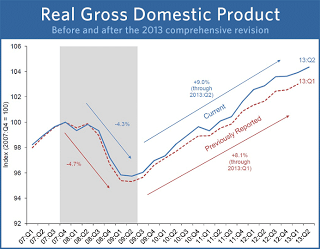Economia

- Workin’ Man Blues
• There seems to be a widespread belief that Brazilian potential GDP growth stands at 4% to 4.5%, transparent not only in consensus forecasts suggesting that growth should trend back to those levels in the next couple of years, but also in government...
- Mercado De Trabalho
A new study argues cutting unemployment benefits created 1.8 million jobs Just looking at the economy's overall size, you wouldn't think that the last year was much different from any of the others since the recession. The U.S....
- Crescimento Econômico
Brazil 2012 Growth Forecasts Slashed December 4, 2012 | Filed underBusiness | Posted by Ben Tavener By Ben Tavener, Senior Contributing Reporter SÃO PAULO, BRAZIL – The 2012 growth forecast for the Brazilian economy has been cut for the third consecutive...
- Estados Unidos E China Em Comparação
We invite you to predict when China will overtake America AMERICA'S GDP is still roughly twice as big as China’s (using market exchange rates). To predict when the gap might be closed, The Economist has updated its interactive chart below with...
- A Maior Bolha Da Historia
By MARC FABER The world has gone from the greatest synchronized global economic boom in history to the first synchronized global bust since the Great Depression. How we got here is not a cautionary tale of free markets gone wild. Rather, it's the...
Economia
US - grande revisão do PIB

- Dating back to 1929, the U.S. economy grew at a 3.3% annual pace, which is one-tenth of a percentage point higher than previously published estimates. From 2002 to 2012, the growth rate was 1.8%, up from a previously reported 1.6% pace.
- Intellectual property, which includes research and development, entertainment and the arts, and software, grew by 13% in 1997 from the prior year, as the Internet bubble began. But by 2001 growth had slowed and only rose 0.5% from a year earlier. By 2012, the categories’ contributions to overall growth were negligible.
- The BEA also tweaked how it calculates pension contributions. The agency will now consider compensation to reflect the value of the pension promises made by the employer, rather than the employer’s cash contributions to the pension fund. The new method better reflects the retirement benefits a worker earns while working and is consistent with business accounting standards, BEA said. As a result, the personal savings rate averaged 4.7%, an upward revision of one percentage point, for the period between 2002 and 2012.
- In 2012, the economy expanded at a 2.8% pace versus a previous estimate of 2.2%. But that performance was wildly uneven over the course of the year, with a strong 3.7% annualized pace in the first quarter after a big upward revision, followed by two middling quarters and finally an abysmal 0.1% growth rate in the final quarter of the year. In current dollar figures the revisions added nearly $560 billion to the overall figure 2012 GDP figure of $16.2 trillion.
- The great recession was less severe than previously thought, with the economy shrinking at an average annual pace of 2.9%, revised from a 3.2% contraction. The recession stretched, officially, from December 2007 through June 2009, according to the National Bureau of Economic Research, which determines the widely accepted benchmarks for U.S. business cycles.
- The current recovery, while revised to show stronger growth, is still the weakest since World War II. The economy expanded at an average 2.3% annual pace between the second quarter of 2009 and the fourth quarter of 2012, compared with a previously published 2.1% pace
- MAIS
loading...
- Workin’ Man Blues
• There seems to be a widespread belief that Brazilian potential GDP growth stands at 4% to 4.5%, transparent not only in consensus forecasts suggesting that growth should trend back to those levels in the next couple of years, but also in government...
- Mercado De Trabalho
A new study argues cutting unemployment benefits created 1.8 million jobs Just looking at the economy's overall size, you wouldn't think that the last year was much different from any of the others since the recession. The U.S....
- Crescimento Econômico
Brazil 2012 Growth Forecasts Slashed December 4, 2012 | Filed underBusiness | Posted by Ben Tavener By Ben Tavener, Senior Contributing Reporter SÃO PAULO, BRAZIL – The 2012 growth forecast for the Brazilian economy has been cut for the third consecutive...
- Estados Unidos E China Em Comparação
We invite you to predict when China will overtake America AMERICA'S GDP is still roughly twice as big as China’s (using market exchange rates). To predict when the gap might be closed, The Economist has updated its interactive chart below with...
- A Maior Bolha Da Historia
By MARC FABER The world has gone from the greatest synchronized global economic boom in history to the first synchronized global bust since the Great Depression. How we got here is not a cautionary tale of free markets gone wild. Rather, it's the...
